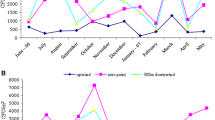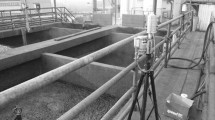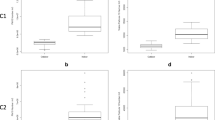Abstract
This study investigates the exposure of workers to biological particles in a poultry litter burning plant in operation. The microorganism concentrations were examined at different workplaces during procedures leading to increased emissions. The concentrations of culturable airborne mesophilic, xerophilic and thermophilic microorganisms in the ambient air were tested inside and outside of the burning plant using two different methods of measuring. The focus of this study was on the quantitative evaluation of culturable bacteria as well as the quantitative and qualitative evaluation of gram-negative bacteria, fungi and thermophilic actinomycetes. The maximum airborne concentrations were found in the delivery hall. Mesophilic bacteria concentrations reached up to 1.7 × 106 CFU/m3; gram-negative bacteria up to 9.1 × 102 CFU/m3. Fungal propagule concentrations for xerophilic fungi were between 1.2 × 103 and 2.9 × 104 CFU/m3 and for mesophilic fungi between 4.4 × 102 and 2.9 × 104 CFU/m3. Among fungi, Aspergillus niger, Eurotium herbariorum and Scopulariopsis brevicaulis species were dominant. Thermophilic actinomycetes reached airborne concentrations of 8.7 × 104 CFU/m3, with increased concentrations of the pathogens causing extrinsic allergic alveolitis. The high concentrations of airborne microorganisms in poultry litter burning plants and the potential hazard of the intake of microorganisms including potential pathogens require the introduction of consistent measures in both technical areas and personnel management.

Similar content being viewed by others
References
Allen, V. M., Hinton, M. H., Tinker, D. B., Gibson, C., Mead, G. C., & Wathes, C. M. (2003). Microbial cross-contamination by airborne dispersion and contagion during defeathering of poultry. British Poultry Science, 44, 567–576.
Andersen, A. A. (1958). New sampler for the collection, sizing and enumeration of viable airborne particles. Journal of Bacteriology, 76, 471–484.
Boltze, H. J. (1992). Allgemeine Labormethodik, Kulturmethoden. In F. Burkhardt (Ed.), Mikrobiologische Diagnostik (pp. 608–611). Stuttgart, New York: Thieme.
Bünger, J., Antlauf-Lammers, M., Schulz, T., Westphal, G., Muller, M., Ruhnau, P., et al. (2000). Health complaints and immunological markers of exposure to bioaerosols among biowaste collectors and compost workers. Occupational Environmental Medicine, 57, 458–464.
Bünger, J., Schappler-Scheele, B., Hilgers, R., & Hallier, E. (2007). A 5-year follow-up study on respiratory disorders and lung function in workers exposed to organic dust from composting plants. International Archives of Occupational and Environmental Health, 80, 306–312.
Danuser, B. (2000). Respiratorische Gesundheitsrisiken bei Arbeiten mit Hühnern. Pneumologie, 54, 37–42.
De Hoog, G. S., & Guarro, J. (1995). Atlas of clinical fungi. Spain: Centraalbureau voor Schimmelcultures Baarn, Delft and Universitat Rovira i Virgili Reus.
Douwes, J., Thorne, P., Pearce, N., & Heederik, D. (2003). Bioaerosol health effects and exposure assessment: Progress and prospects. Annals of Occupational Hygiene, 47(3), 187–200.
Douwers, J., Wouters, I., Dubbeld, H., Van Zwieten, L., Steerenberg, P., & Doekes, G. H. (2000). Upper airway inflammation assessed by nasal lavage in compost workers: A relation with bioaerosol exposure. American Journal Industrial Medicine, 37(5), 459–468.
Epstein, E., Wu, N., Youngberg, C., & Crouteau, G. (2001). Dust and bioaerosols at a biosolids composting facility. Compost Science & Utilization, 9(3), 250–255.
Göttlich, E., Engesser, K. H., & Bardtke, D. (1994). Emission von Pilzsporen in Müllverarbeitungsanlagen. Forum Städte Hygiene, 45, 321–325.
Gray, G. C., Trampel, D. W., & Roth, J. A. (2007). Pandemic influenza planning: Shouldn’t swine and poultry workers be included? Vaccine, 25, 4376–4381.
Haas, D., Posch, J., Schmidt, S., Wuest, G., Sixl, W., Feierl, G., et al. (2005). A case study of airborne culturable microorganisms in a poultry slaughterhouse in Styria, Austria. Aerobiologia, 21, 193–201.
Haas, D. U., Reinthaler, F. F., Wuest, G., Skofitsch, G., Groth, I., Degenkolb, T., et al. (1999). Emission of thermophilic Actinomycetes in composting facilities, their immediate surroundings, and in an urban area. Central European Journal Public Health, 2(7), 94–99.
Hagmar, L., Schütz, A., Hallberg, T., & Sjöholm, A. (1990). Health effects of exposure to endotoxins and organic dust in poultry slaughter-house workers. International Archives of Occupational and Environmental Health, 62, 159–164.
Hein, I., Schneck, C., Knögler, M., Feierl, G., Pless, P., Köfer, J., et al. (2003). Campylobacter jejuni isolated from poultry and humans in Styria, Austria: Epidemiology and ciprofloxacin resistance. Epidemiology and Infection, 130, 377–386.
Hryhorczuk, D., Scheff, P., Chung, J., Rizzo, M., Lewis, C., Keys, N., et al. (2001). Bioaerosol emissions from a suburban yard waste composting facility. Annals of Agricultural and Environmental Medicine, 8, 177–185.
Huiyong, D. (2008). Transmission identification of Escherichia coli aerosol in chicken houses to their environments using ERIC-PCR. Science in China Series C: Life Sciences, 51(2), 164–173.
Jager, E., Henning, R., & Zeschmar-Lahl, B. (1994). Composting facilities: 2 communication: Airborne micro-organisms at different working places at composting facilities. Zentralblatt für Hygiene und Umweltmedezin, 196, 367–379.
Kempf, A. (1995). Untersuchungen über thermophile Aktinomyzeten: Taxonomie, Ökologie und Abbau von Biopolymeren. Ph.D. Thesis, Fachbereich Biologie der Technischen Hochschule Darmstadt.
Kilch, M. A. (1988). A laboratory guide to common Aspergillus species and their teleomorphs. North Ryde, Australia: Commonwealth Scientific and Industrial Research Organization, Division of Food Processing.
Lacey, J., & Crook, B. (1988). Fungal and actinomycete spores as pollutants of the workplace and occupational allergens. Annals of Occupational Hygiene, 32, 513–533.
Lacey, J., Pepys, J., & Cross, T. (1992). Actinomycete and fungus spores in air as respiratory allergens. In D. A. Shapton & R. C. Board (Eds.), Safety in microbiology (pp. 151–184). London: Academic Press.
Liebers, V., Brüning, T., & Raulf-Heimsoth, M. (2006). Occupational endotoxin-exposure and possible health effects on humans. American Journal of Industrial Medicine, 49, 474–491.
Lues, F. R., Theron, M. M., Venter, P., & Rasephei, M. H. R. (2007). Microbial composition in bioaerosols of a high-throughput chicken-slaughtering facility. Poultry Science, 86, 142–149.
Marchand, G., Lavoie, J., & Lazure, L. (1995). Evaluation of bioaerosols in a municipal solid waste recycling and composting plant. Air and Waste Management Association, 45, 778–781.
Meier, R., & Zingre, H. (2000). Qualification of air sampler systems: The MAS-100®. Swiss Pharma, 22(1–2), 15–21.
Millner, P., Olenchok, S. A., Epstein, E., Rylander, R., Haines, J., Walker, J., et al. (1994). Bioaerosols associated with composting facilities. Compost Science and Utilization, 2(4), 6–57.
Neumann, H. D., Balfanz, J., Becker, G., Lohmeyer, M., Mathys, W., & Raulf-Heimsoth, M. (2002). Bioaerosol exposure during refuse collection: Results of field studies in the real-life situation. The Science of the Total Environment, 293, 219–231.
Nielsen, E. M., Breum, N. O., Nielsen, B. H., Wtirtz, H., Poulsen, O. M., & Midtgaard, U. (1997). Bioaerosol exposure in waste collection: A comparative study on the significance of collection equipment, type of waste and seasonal variation. Annals of Occupational Hygiene, 41(3), 325–344.
Oppliger, A., Charrière, N., Droz, P. O., & Rinsoz, T. H. (2008). Exposure to bioaerosols in poultry houses at different stages of fattening; Use of real-time PCR for airborne bacterial quantification. Annals of Occupational Hygiene, 52, 405–412.
Poulsen, O. M., Breum, N. O., Ebbehoj, N., Hansen, A. M., Ivens, U. I., van Lelieveld, D., et al. (1995). Collection of domestic waste. Review of occupational health problems and their possible causes. The Science of the Total Environment, 170, 1–19.
Radon, K., Danuser, B., Jversen, M., Monso, E., Weber, C., Hartung, J., et al. (2002). Air contaminants in different European farming environments. Annals of Agricultural and Environmental Medicine, 9, 41–48.
Recer, G. M., Browne, M. L., Horn, E., Hill, K., & Boehler, W. (2001). Ambient air levels of Aspergillus fumigatus and thermophilic actinomycetes in a residential neighbourhood near a yard waste composting facility. Aerobiologia, 17, 99–108.
Reinthaler, F. F., Haas, D. U., Feierl, G., Schlacher, R., Pichler-Semmelrock, F. P., Köck, M., et al. (1999). Comparative investigations of airborne culturable microorganisms in selected waste treatment facilities and in neighbouring areas. Zentralblatt für Hygiene und Umweltmedizin, 202, 1–17.
Rylander, R. (1999). Health effects among workers in sewage treatment plants. Occupational Environmental Medicine, 56, 354–357.
Rylander, R., & Carvalheiro, M. F. (2006). Airways inflammation among workers in poultry houses. International Archives of Occupational and Environmental Health, 79, 487–490.
Samson, R. A., Hoekstra, E. S., Frisvad, J. C., & Filtenborg, O. (1996). Introduction to food-borne fungi (5th ed.). Wageningen, Netherlands: Centraalbureau voor Schimmelcultures Baarn, Delft. Printed by Ponsen and Looyen.
Schierl, R., Heise, A., Egger, U., Schneider, F., Eichelser, R., Neser, S., et al. (2007). Endotoxin concentration in modern animal houses in southern Bavaria. Annals of Agricultural and Environmental Medicine, 14, 129–136.
Streib, R., Botzenhart, K., Drysch, K., & Rettenmeier, A. W. (1996). Assessment of exposure to dust and micro-organisms during delivery, sorting and composting of domestic and industrial waste materials. Zentralblatt für Hygiene und Umweltmedizin, 198, 531–551.
Tesseraux, I. (2005). Monitoring in ambient air at different locations, seasonal variations. Mikrobielle Luftverunreinigungen. KRdL-Schriftenreihe, 35, 89–100.
Wang, Y., Chai, T., Lu, G., Quan, C., Duan, H., Yao, M., et al. (2008). Simultaneous detection of airborne Aflatoxin, Ochratoxin and Zearalenone in a poultry house by immunoaffinity clean-up and high-performance liquid chromatography. Environmental Research, 107, 139–144.
Wijnand, E. (2007). The nordic expert group for criteria documentation of health risks from chemicals. In S. Marklund (Ed.), 139. Fungal spores. ISBN 978-91-7045-825-5. http://www.inchem.org/documents/kemi/kemi/ah2006_21.pdf. Accessed 20 May 2009.
Wuest, G., Reinthaler, F. F., Haas, D. U., & Marth, E. (1999). Vergleichende Untersuchungen luftgetragener, kultivierbarer Mikroorganismen an ausgewählten Standorten in der Abfallwirtschaft, der Nutztierhaltung und im Anwohnerbereich. In T. Eikmann & R. Hofmann (Eds.), Schriftenreihe des Vereins für Wasser-, Boden- und Lufthygiene: Stand von Wissenschaft, Forschung und Technik zu siedlungshygienischen Aspekten der Abfallentsorgung und—verwertung, Langen, Germany, 30th August to 1st September 30, 703–711.
Zucker, B. A., & Müller, W. (2004). Airborne microorganisms in animal stables: Stability of endotoxins in the environment. Berliner und Münchner Tierärztliche Wochenschrift, 117(1–2), 6–11.
Author information
Authors and Affiliations
Corresponding author
Rights and permissions
About this article
Cite this article
Wultsch, G., Haas, D., Galler, H. et al. Bioaerosol emissions in a poultry litter burning plant. Aerobiologia 26, 63–73 (2010). https://doi.org/10.1007/s10453-009-9143-5
Received:
Accepted:
Published:
Issue Date:
DOI: https://doi.org/10.1007/s10453-009-9143-5




